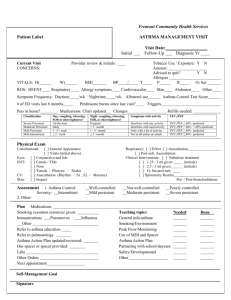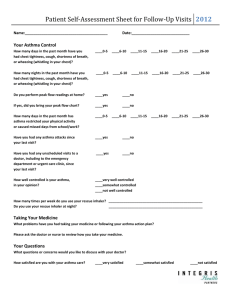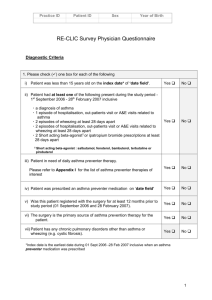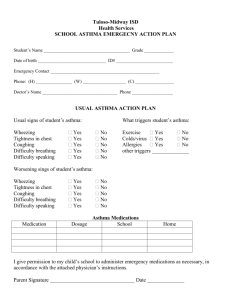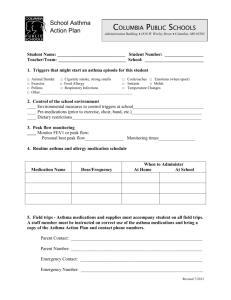ASTHMA
advertisement
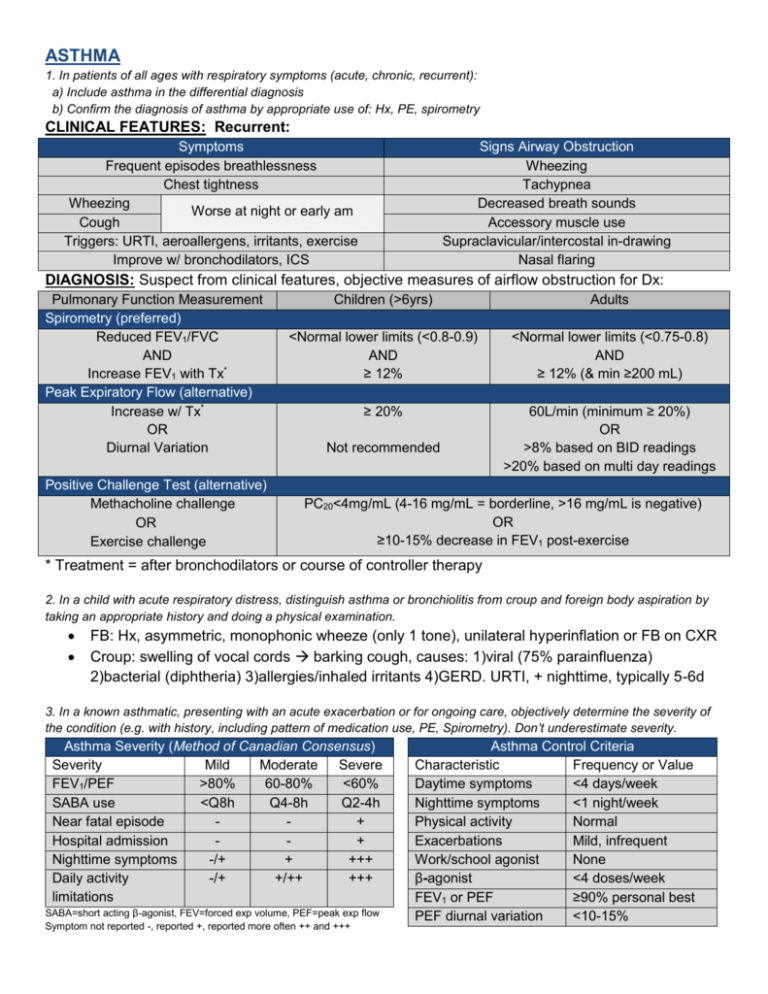
ASTHMA 1. In patients of all ages with respiratory symptoms (acute, chronic, recurrent): a) Include asthma in the differential diagnosis b) Confirm the diagnosis of asthma by appropriate use of: Hx, PE, spirometry CLINICAL FEATURES: Recurrent: Symptoms Frequent episodes breathlessness Chest tightness Wheezing Worse at night or early am Cough Triggers: URTI, aeroallergens, irritants, exercise Improve w/ bronchodilators, ICS Signs Airway Obstruction Wheezing Tachypnea Decreased breath sounds Accessory muscle use Supraclavicular/intercostal in-drawing Nasal flaring DIAGNOSIS: Suspect from clinical features, objective measures of airflow obstruction for Dx: Pulmonary Function Measurement Spirometry (preferred) Reduced FEV1/FVC AND Increase FEV1 with Tx* Peak Expiratory Flow (alternative) Increase w/ Tx* OR Diurnal Variation Positive Challenge Test (alternative) Methacholine challenge OR Exercise challenge Children (>6yrs) Adults <Normal lower limits (<0.8-0.9) AND ≥ 12% <Normal lower limits (<0.75-0.8) AND ≥ 12% (& min ≥200 mL) ≥ 20% 60L/min (minimum ≥ 20%) OR >8% based on BID readings >20% based on multi day readings Not recommended PC20<4mg/mL (4-16 mg/mL = borderline, >16 mg/mL is negative) OR ≥10-15% decrease in FEV1 post-exercise * Treatment = after bronchodilators or course of controller therapy 2. In a child with acute respiratory distress, distinguish asthma or bronchiolitis from croup and foreign body aspiration by taking an appropriate history and doing a physical examination. FB: Hx, asymmetric, monophonic wheeze (only 1 tone), unilateral hyperinflation or FB on CXR Croup: swelling of vocal cords barking cough, causes: 1)viral (75% parainfluenza) 2)bacterial (diphtheria) 3)allergies/inhaled irritants 4)GERD. URTI, + nighttime, typically 5-6d 3. In a known asthmatic, presenting with an acute exacerbation or for ongoing care, objectively determine the severity of the condition (e.g. with history, including pattern of medication use, PE, Spirometry). Don’t underestimate severity. Asthma Severity (Method of Canadian Consensus) Severity Mild Moderate Severe FEV1/PEF >80% 60-80% <60% SABA use <Q8h Q4-8h Q2-4h Near fatal episode + Hospital admission + Nighttime symptoms -/+ + +++ Daily activity -/+ +/++ +++ limitations SABA=short acting β-agonist, FEV=forced exp volume, PEF=peak exp flow Symptom not reported -, reported +, reported more often ++ and +++ Asthma Control Criteria Characteristic Frequency or Value Daytime symptoms <4 days/week Nighttime symptoms <1 night/week Physical activity Normal Exacerbations Mild, infrequent Work/school agonist None β-agonist <4 doses/week FEV1 or PEF ≥90% personal best PEF diurnal variation <10-15% Treatment 4. In a known asthmatic with an acute exacerbation: a) Treat the acute episode (e.g. β-agonists repeatedly and early steroids, and avoid under-treatment). b) Rule out co-morbid disease (e.g. CHF, COPD). c) Determine the need for hospitalization or D/C (basing the decision on the risk of recurrence or complications, and on the patient’s expectations and resources). 5. For the ongoing (chronic) treatment of an asthmatic propose a stepwise management plan including: a) self-monitoring b) self-adjustment of medication c) when to consult back Create an Asthma Action Plan http://www.lung.ca/_resources/asthma_action_plan.pdf 6. For a known asthmatic patient, who has ongoing or recurrent symptoms: a) Assess severity & compliance with med regimens b) Recommend lifestyle adjustments (e.g. avoiding irritants, triggers) for less recurrence & better control References: 1) Lougheed et.al. Canadian Thoracic Society Asthma Management Continuum-2010 Consensus Summary for children six years of age and over, and adults. Can Resp J Vol17:1;2010. 2) Colice G. Categorizing Asthma Severity: An Overview of National Guidelines. Clinical Med & Research. Vol 2(3): 155-63:2004 Sample Case Asthma (18 points) Jamie is a seven-year-old boy who is brought to your office by his mother. He has a one-month history of dry cough, which is worse at night, and wheezing. The wheezing seems to be getting worse. His mother states that “colds seem to go to his chest”. The chest is clear on auscultation and percussion. An X-ray film of the chest was reported as normal. 1. Excluding family history, what additional information would be important in this child’s history? List SIX. 1. 2. 3. 4. 5. 6. 2. If you were quite certain that Jamie has asthma, what would be your initial treatment/management steps? List FOUR. 1. 2. 3. 4. Despite adequate initial treatment, Jamie’s condition deteriorates and he presents at the emergency department one week later. You determine from the history and examination that he is in status asthmaticus. 3. In point form, give the stepwise management of status asthmaticus in this child. Arterial blood gases and peak expiratory flow measurements have been done. The patient’s condition is being continuously monitored and reassessed. Assume his condition continues to deteriorate throughout treatment. List EIGHT steps. 1. 2. 3. 4. 5. 6. 7. 8. Sample Case #10 Answers Question 1 Child’s history of atopy Child’s history of asthma Child’s history of allergies Use of medications Recent infection History suggestive of foreign body aspiration Question 2 Patient education Removing precipitating factors Inhaled beta-agonist Peak-flow meter Question 3 Supplemental oxygen (O2) Nebulized salbutamol (Ventolin) Subcutaneous epinephrine Intravenous (IV) steroids IV fluids Admission to the intensive care unit (ICU) IV salbutamol Intubation

